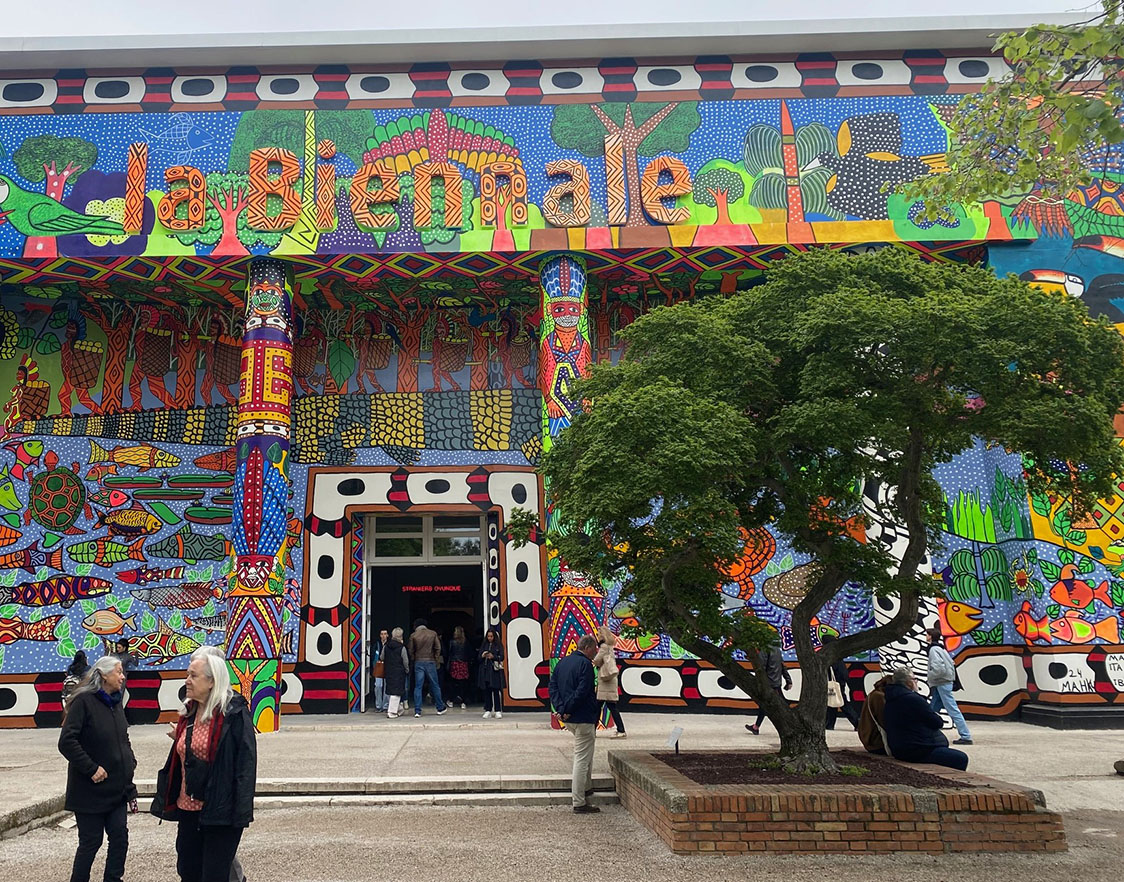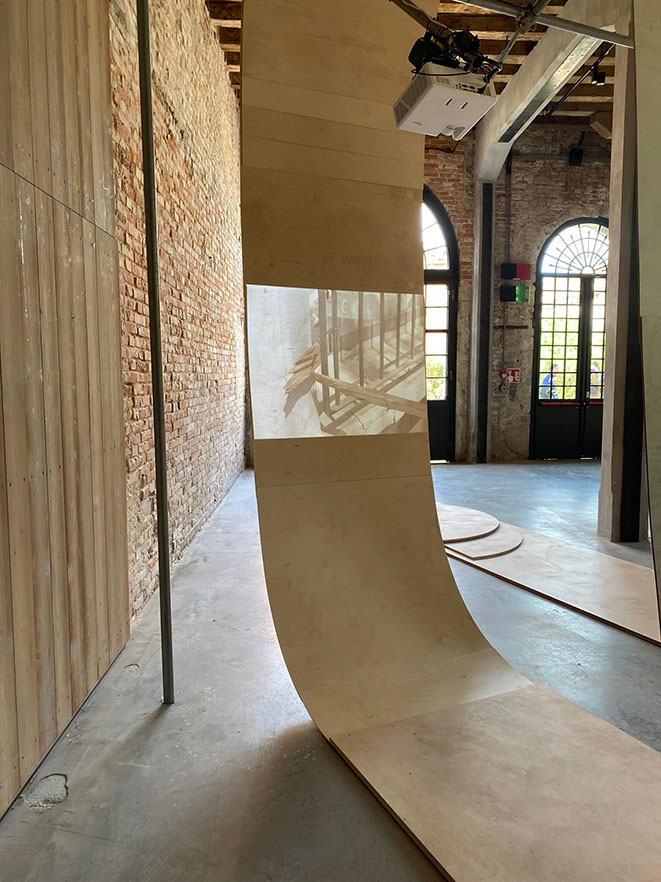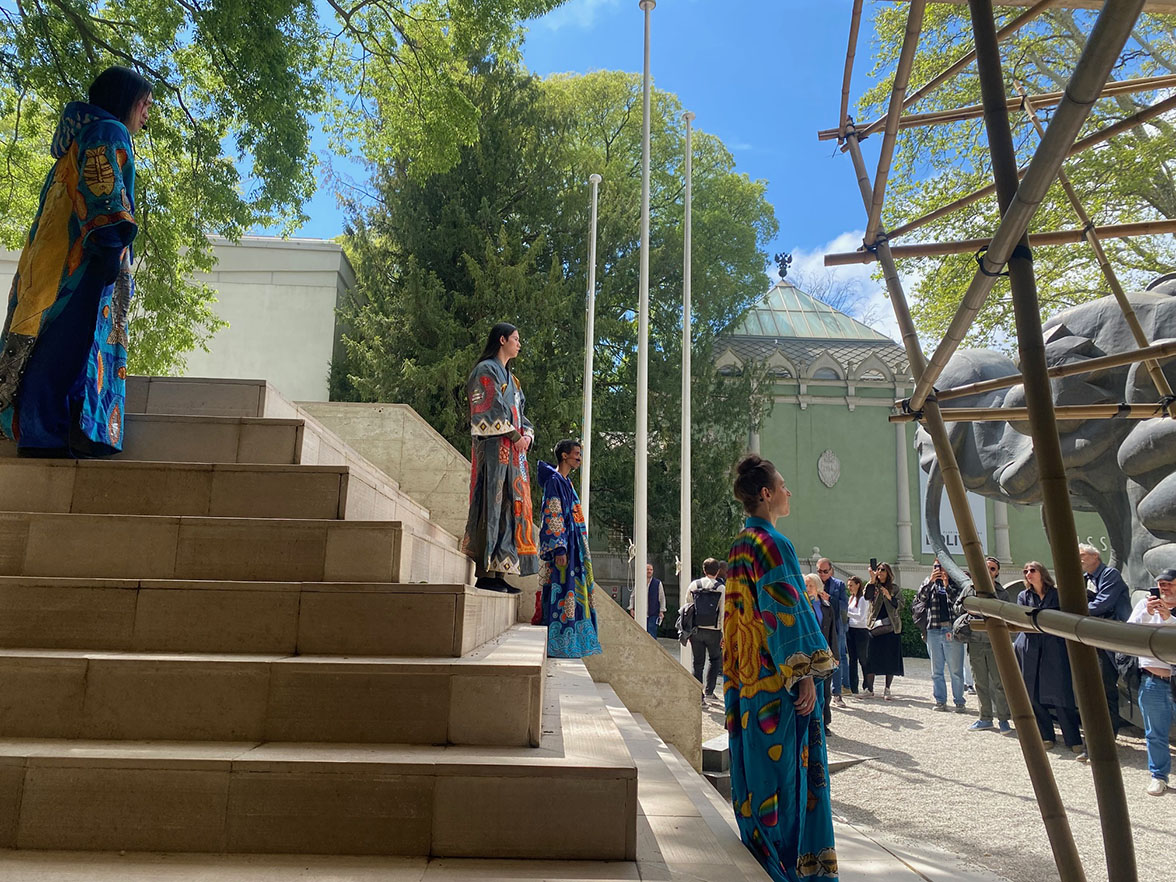“Foreigners everywhere” (Stranieri Ovunque) is the leitmotiv of this 60th edition of the Venice Biennale, without a doubt the oldest international art exhibition (born in 1895) and the most prestigious – or at least the one the planet look more carefully.
It could be said that Venice was the seat of the invention of biennials. And this time, having been able to visit it in its last three editions, I wonder what its future could be. This time I sensed something of imminence, a tension that – without a doubt – responds to the moment of anguish about the future that the planet is experiencing: with two ongoing wars that could at any moment escalate into global conflagrations, with evidence of climate change swift and inexorable, and with terrible conflicts between ever-increasing multitudes that find themselves displaced towards – and rejected from – the economic powers that increasingly close their borders.
In art biennials, not only an aesthetic canon is put on stage. Ideas, problems, concepts and urgencies are proposed that both the artists and the curators with their well-tuned antennas consider that they should be the object of reflection by the multitudes who visit it and those who watch and read it from a distance in comments and criticisms to the width and length of the planet.
Adriano Pedrosa, the general curator of this biennial, is the first South American to be chosen for that role. His choice of the convening theme could not be more timely. His source of inspiration has been the Claire Fontaine artist collective, with a very positive concept of the condition of a foreigner: one who always has a strange, traveler's gaze, and makes his creativity and critical capacity grow from there. . However, in the work of many artists participating in this biennial, this concept is transfigured with extraordinary political potential: foreigners were the European colonizers of the immense latitudes of America, Africa, Australia, etc. Foreigners today are the poor emigrants displaced from those former emancipated colonies. Foreigners, political emigrants. Foreign, strange, extravagant human animals that attack, subjugate and destroy all other animals and that are also destroying terrestrial ecosystems.
All these issues emerge in this edition of the Venice Biennale, although not so much in the central exhibition curated by Pedrosa, but rather they are displayed in countless nuances in the national pavilions.
Portraits, in the historic core of the Central Pavilion. Photography: Laura Malosetti Costa.
The central exhibition has been much discussed. It is said that the curator wanted to discuss the European canon and that is why he has chosen a large number of Latin American artists who have never been in a biennial. He himself has placed emphasis on this issue both in his texts and in the reports that have been made of him. There are even several historic rooms in which he displayed works by 20th-century Latin American artists in an arrangement that looks more like a modern art museum than a biennial. In fact, the curator is the artistic director of the Sao Paulo Art Museum (MASP) and it shows. The texts that accompany each piece end (almost always) with the phrase: “This artist never appeared in the Venice Biennale.” Both the organizing principle of his search and the result were somewhat disappointing to me. There have been Latin American artists at the Venice Biennale since 1903, some of them winning gold lions. And this time they were not there (Argentines Antonio Berni, León Ferrari and Liliana Porter among them). But Pedrosa not only organized a kind of Hall for the Excluded, but also generally renounced the spectacle that always appears necessary to awaken the attention of visitors in such a vast set of immense spaces, dozens of pavilions, many kilometers to walk through. day, in short, the strategies to retain the interest of the spectators. It is very exhausting for the public to try to look carefully, understand, enjoy, and be moved by such an immense number of works. In the central exhibition the curator multiplied the number of artists and reduced – in general – the dimensions of the works exhibited. It has garnered few favorable comments, although there are very outstanding works by artists such as Annamaria Maiolino, Nil Yalter, Chola Poblete, (which were awarded) and notable works of textile art such as that of the embroiderers of Isla Negra in Chile with an immense and magnificent tapestry that had been stolen during the last dictatorship.
Benin Pavilion, “all the precious is fragile”. Photography: Laura Malosetti Costa.
In the national pavilions that I was able to visit (they are deployed not only in the Arsenale and Giardini sections of the Biennale grounds but also in various buildings scattered throughout the city) the African presence was very powerful to me. Cameroon, Congo, Ivory Coast, Ethiopia, Nigeria, Tanzania, Uganda and Zimbabwe (several of these first-time participating nations) installed their national pavilions in buildings outside the biennale grounds. And it was two African pavilions: Benin's in Arsenale (also participating for the first time) and Egypt's in Giardini, that impressed me the most. “Everything precious is fragile” is the name of the installation by the collective made up of Chloè Quenum, Moufouli Bello, Ishola Akpo and Romuald Hazoumè, curated by Azu Henry Nwagbogu, which delves with effective poetics into ancestral female traditions, the history of trafficking slaves, ancient deities and women as a promise of a better future and a present marked by needs that are materialized in a shelter made with plastic drums: essential for life transporting and preserving water.
Unforgettable, the work of Wael Shawky in the Egyptian Pavilion. Photography: Laura Malosetti Costa.
“Drama 1882” is the name of the extraordinary work by Wael Shawky that is presented in the Egyptian pavilion. It is an opera for which the artist composed the music, the choreography, the script and the sets, directed and filmed by himself in which, in a very particular tone that oscillates between tragedy and comedy and an extraordinary aesthetic which borders on abstraction, tells the terrible story of the defeat, in 1882 at the hands of diplomacy and English and North American troops, of the nationalist revolution of the Orabi who in 1879 had managed to gain independence from imperial rule.
Also in the pavilion of the Nordic countries (Sweden, Norway and Finland) an extraordinary musical performance work is displayed: “The Altersea Opera”, inspired by the ancient tradition of Cantonese opera, with a display of beautiful costumes, and a nostalgic tone with which the ancestral link with water is evoked in the past, the present and a future that is perceived as dark and threatening.
Music, the word, the moving image have an important presence in several of the most impressive pavilions of the Biennial, such as that of Great Britain (“Listening all night to the rain” by John Akomfrath), Germany (“Thresholds” by a group of artists curated by Cagia Ilk), Switzerland (“Super Superior Civilizations” by Swiss Brazilian artist Guerreiro do Divino Amor), with dark looks into the predatory past of those nations and apocalyptic predictions.
Netherlands Pavilion, Cocoa Cooperative. Photography: Laura Malosetti Costa.
Other European nations decided to cede their pavilions to former colonies or to groups of African or American nations: that of the Netherlands was ceded to a cooperative of cocoa gatherers from the Congo: “The international celebration of blasphemy and the sacred” raises ethical and economic questions that never appear in the exclusive circles of art: the sculptures of ancestral deities made of cocoa and that flood the pavilion with their terrible appearance and their delicious perfume are for sale and their profit will go to that cooperative in which the workers earn on average less than twenty or dollars per month.
The Russian pavilion was given to artists from Bolivia, including Alexandra Bravo, who presented extraordinary works of feather art and textiles, ancestral techniques with very contemporary messages referring to the situation of undocumented migrants and Bolivian working women.
For the first time in its history, Spain gave its pavilion to an artist from one of its main former colonies: the Peruvian Sandra Gamarra, who gives a terrible review of the Spanish conquest in America through her installation “Migrant Pinacoteca”.
Australian Pavilion. Photography: Laura Malosetti Costa.
The Golden Lion was awarded to the Australian pavilion, which selected an extraordinary work by artist Archie Moore, who presents himself as a descendant of the Australian first nations [traditionally relegated to reserves and settlements far from large cities]. The artist drew in chalk on the immense, blackened walls of the pavilion 65,000 years of his genealogy, which he recognizes as Kamilaroi, Bigambul and British. His work: “Kith and Kin” is completed with a mournful installation of sentences, documents and statistics of violent deaths in the middle of a reflecting pool, central to the mourning of the Australian indigenous peoples.
Uruguay Pavilion with a detail of the work of Eduardo Cardozo. Photography: Laura Malosetti Costa.
Finally, I would like to comment on the pavilions of my two homelands: that of Uruguay in the Giardini and that of Argentina in the Arsenale. The Uruguayan artist Eduardo Cardozo settled as a foreigner in Venice, moving the peeling walls of his Montevideo workshop to dialogue with none other than Tintoretto, one of whose main works: Paradise, he recreates three-dimensionally in a poetic installation of finely colored and illuminated cloths that They evoke the movement of the figures of the great canvas of the greatest Venetian artist.
Argentina Pavilion with Luciana Lamothe. Photography: Laura Malosetti Costa.
In the Argentine pavilion, Luciana Lamothe displays a curvilinear structure of polished plywood that makes us evoke the idea of infinity, crossed by trunks, sharp elements, accidents that evoke violence and breaks that, however, do not prevent its soft presence and the invitation to share that space. “I hope all the doors open” is the name of that installation in which you see and hear videos in which the artist destroys doors with hammer blows and which give us a beautiful key to interpretation: Argentina always opening the doors, as a country of foreigners, one litter upon another, always willing and generous with the new ones. Hopefully this long tradition does not end and all the doors continue to open...
* Special for Hilario. Arts Letters Trades



